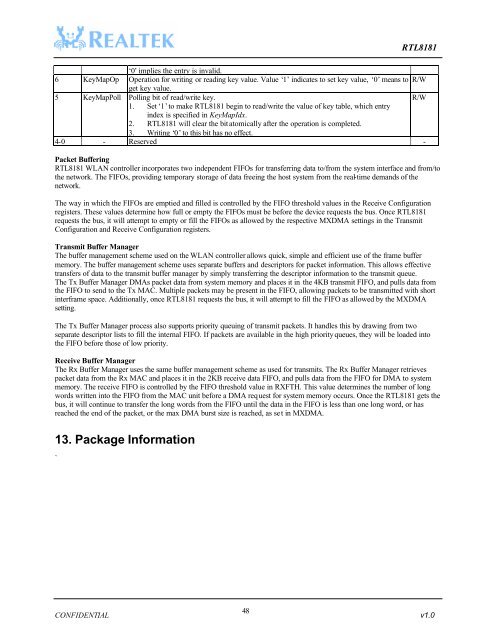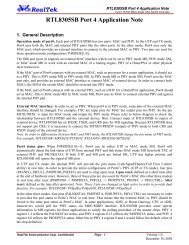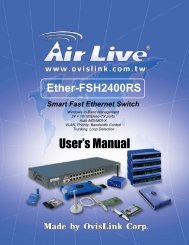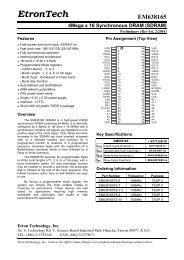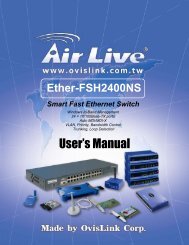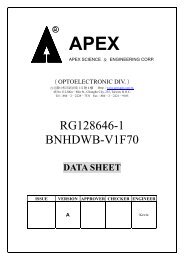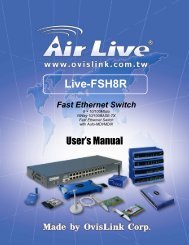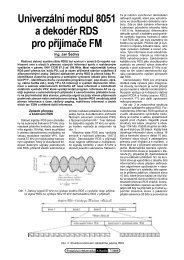RTL8181 Wireless LAN Access Point/Gateway Controller DATA ...
RTL8181 Wireless LAN Access Point/Gateway Controller DATA ...
RTL8181 Wireless LAN Access Point/Gateway Controller DATA ...
- No tags were found...
You also want an ePaper? Increase the reach of your titles
YUMPU automatically turns print PDFs into web optimized ePapers that Google loves.
<strong>RTL8181</strong>‘0’ implies the entry is invalid.6 KeyMapOp Operation for writing or reading key value. Value ‘1’ indicates to set key value, ‘0’ means to R/Wget key value.5 KeyMapPoll Polling bit of read/write key.R/W1. Set ‘1’ to make <strong>RTL8181</strong> begin to read/write the value of key table, which entryindex is specified in KeyMapIdx.2. <strong>RTL8181</strong> will clear the bit atomically after the operation is completed.3. Writing ‘0’ to this bit has no effect.4-0 - Reserved -Packet Buffering<strong>RTL8181</strong> W<strong>LAN</strong> controller incorporates two independent FIFOs for transferring data to/from the system interface and from/tothe network. The FIFOs, providing temporary storage of data freeing the host system from the real-time demands of thenetwork.The way in which the FIFOs are emptied and filled is controlled by the FIFO threshold values in the Receive Configurationregisters. These values determine how full or empty the FIFOs must be before the device requests the bus. Once <strong>RTL8181</strong>requests the bus, it will attempt to empty or fill the FIFOs as allowed by the respective MXDMA settings in the TransmitConfiguration and Receive Configuration registers.Transmit Buffer ManagerThe buffer management scheme used on the W<strong>LAN</strong> controller allows quick, simple and efficient use of the frame buffermemory. The buffer management scheme uses separate buffers and descriptors for packet information. This allows effectivetransfers of data to the transmit buffer manager by simply transferring the descriptor information to the transmit queue.The Tx Buffer Manager DMAs packet data from system memory and places it in the 4KB transmit FIFO, and pulls data fromthe FIFO to send to the Tx MAC. Multiple packets may be present in the FIFO, allowing packets to be transmitted with shortinterframe space. Additionally, once <strong>RTL8181</strong> requests the bus, it will attempt to fill the FIFO as allowed by the MXDMAsetting.The Tx Buffer Manager process also supports priority queuing of transmit packets. It handles this by drawing from twoseparate descriptor lists to fill the internal FIFO. If packets are available in the high priority queues, they will be loaded intothe FIFO before those of low priority.Receive Buffer ManagerThe Rx Buffer Manager uses the same buffer management scheme as used for transmits. The Rx Buffer Manager retrievespacket data from the Rx MAC and places it in the 2KB receive data FIFO, and pulls data from the FIFO for DMA to systemmemory. The receive FIFO is controlled by the FIFO threshold value in RXFTH. This value determines the number of longwords written into the FIFO from the MAC unit before a DMA request for system memory occurs. Once the <strong>RTL8181</strong> gets thebus, it will continue to transfer the long words from the FIFO until the data in the FIFO is less than one long word, or hasreached the end of the packet, or the max DMA burst size is reached, as set in MXDMA.13. Package Information`48CONFIDENTIAL v1.0


